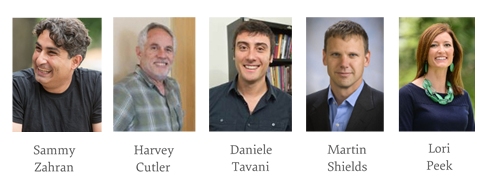As appearing in SOURCE
When a natural disaster like a flood, fire or hurricane hits a community, what factors go into a rapid recovery? What makes that community resilient, able to bounce back better than ever?
Colorado State University researchers are charting new territory to answer those questions, unifying the efforts of engineers, social scientists, economists and urban planners.
The multi-university Center for Risk-Based Community Resilience Planning based at CSU has just completed year one of a five-year, $20 million cooperative agreement from the U.S. Department of Commerce National Institute of Standards and Technology(NIST). They are charged with tackling the complexities of science-based, first-principles resilience planning.
The Center is directed by engineering professors John W. van de Lindt and Bruce Ellingwood. The Economics team is composed of Department of Economics professors Sammy Zahran, Harvey Cutler, Daniele Tavani, and Martin Shields, as well as 6 economics graduate students. Department of Sociology professor Lori Peek is joined on the Social Sciences team by 2 sociology PhD students.

CSU leads the 10-member NIST Center of Excellence – one of only three NIST centers in the nation – seeking to identify and quantify what makes strong, healthy, hazard-resistant communities. They will make their results available to the research community, city planners, government leaders and the general public.
Public webinar to share first-year results
On April 28 at 9 a.m., the CSU team will lead a public webinar to review their first-year findings and to share next steps. Presentations will include demos highlighting the beta version of a computational environment called NIST-CORE, which is the centerpiece of the project. A question-and-answer chat session will follow.
“The hope is that by using a more science-based approach, decision-makers will be able to come up with tools which are internally consistent, connected together, and recognize that in recovery from a natural disaster, it is not sufficient to focus on physical infrastructure only,” said CSU Professor of Civil and Environmental Engineering Bruce Ellingwood, co-director of the NIST Center. “One must also consider how that physical infrastructure interfaces with the social and economic institutions necessary to make a community healthy and economically viable.”
The team includes engineers like Ellingwood and co-director John van de Lindt; social scientists like Lori Peek, associate professor of sociology, and Professor of Economics Harvey Cutler; as well as collaborators at Texas A&M, the University of Illinois-Urbana Champaign, Oregon State, the University of Oklahoma, the University of Washington and Rice University, to name a few. As a team, this blend of researchers is looking not only at securing physical infrastructure, but also at basic human needs like water, food, jobs, health care and schools.
“The objective of our center is to develop the science of community resilience,” said van de Lindt, George T. Abell Professor of Infrastructure in civil engineering at CSU. “What are the pieces we need to put together to identify the factors and attributes that make a community resilient to hazards?”
The major thrust of the center is to create a methodology for assessing such resilience. To do that, they’re developing an open-source software platform called NIST-CORE for modeling communities and quantifying the factors that make them resilient to natural hazards. The NIST-CORE computing environment is being built on an existing platform that had limited scope, originally funded by the National Science Foundation-sponsored Mid-America Earthquake Center that Ellingwood worked on several years ago.
Centerville: a virtual community
In creating the beta version of NIST-CORE, during year one the researchers have designed a virtual community called Centerville for testing their resilience algorithms. Centerville is a “typical middle-class city situated in a Midwestern state,” with a population of about 50,000.
Cutler, a CSU economist, is contributing his expertise to Centerville with a computable general equilibrium model (CGE) that he designed. Using inputs like damage to buildings, schools, bridges and other infrastructure, Cutler’s program generates a spatial model of the economic damage to a virtual community. Cutler says it’s exciting to interface directly with engineers to increase the sophistication of his previous CGE work.
Another key question the researchers want to answer is, how refined a model will be needed for robust forecasting of disaster scenarios for a given community? Will they need to account for each household, for example, or will their models still work if the community is modeled by city blocks, census or postal districts?
The researchers are required to report their progress every six months to NIST program managers.
Sign up for the webinar , which will be archived shortly afterward on the Center for Risk-Based Community Resilience Planning site.
